
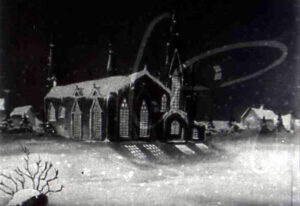
A TWENTIETH CENTURY CHRISTMAS
In the nineteenth century Christmas was a day when good will triumphed over hard hearts, a day when family and good friends came together to enjoy the blessings of good company over a meal, or even a feast if one could afford it. The gifts were the joys of love and good will.
The twentieth century saw the explosion of commercialism at Christmas time, exploiting Santa Claus to sell gifts with an urgency fueled with guilt if we don’t come through with the goods. This commercialism continues unrestrained into the twenty-first century.
But there is still plenty of what we call “the true meaning of Christmas” to be had. You might have to look for it, but it’s there.
Silver Showcase offers some animated and live action motion pictures that offer a glimpse of how we celebrated Christmas in the mid-twentieth century. It’s all served up with a big dollop of warm nostalgia and plenty of smiles.


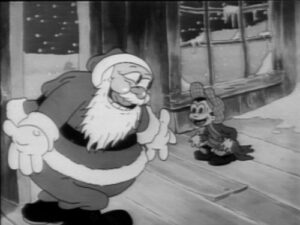
THE SHANTY WHERE SANTY CLAUS LIVES
(Warner Bros., January 7, 1933)
What child hasn’t wished to ride to the north pole with Santa in his sleigh?
This happy cartoon is the product of the Warner Bros. animation department, unofficially known as Termite Terrace. Before Bugs, Daffy and Porky came along, the Warner Bros. specialized in snappy cartoons with toe-tappin’ music, and this cartoon certainly qualifies as a toe tapper.
Released at the bottom of the Great Depression, this Santa story is a metaphor for the millions hoping for something to reach down from the sky and pull them out of disaster. (1981 Canadian Kodak film stock, variable area sound track.)



HOWDY DOODY’S CHRISTMAS
(Castle Films, 1951)
Saving Christmas is a theme as old as the movies. In this film the rescuers are Buffalo Bob Smith (1917-1998), Howdy Doody and Clarabelle the Clown (Bob Keeshan, 1927-2004) who fly to the North Pole on the Rocket Doodle (thanks to stock footage from “Flash Gordon”) to find out why Santa hasn’t come on Christmas Eve.
This fun little film was produced in a New York studio specifically for Castle Films apart from the Howdy Doody television program that was then riding high as the first mega-hit of children’s TV. In addition to “Buffalo” Bob Smith and future Captain Kangaroo Bob Keeshan, we see comedian Dayton Allen as Ugly Sam. The identities of the actor portraying Santa and the actor who (very obviously) dubbed his voice are unknown. (1956 Kodak film stock, variable area sound track)


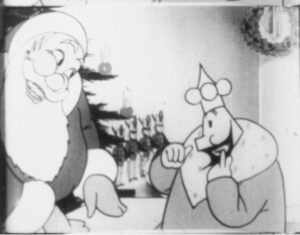
CHRISTMAS NIGHT
Van Buren/RKO, December 22, 1933.
(Original release title was PALS.)
Based on Otto Soglow’s endearing comic strip, “The Little King,” this delightful cartoon presents the sweethearted monarch at his child-like best. Always wishing to escape the mantle of the monarchy, the Little King suffers his position silently and seizes each chance he finds to play with his subjects and bring them happiness.
As this is a pre-code film, (made before the Hays office crack down and firm enforcement of the production code in July of 1934), we see some gently suggestive moments, but nothing that is even close to blatant. The best word to describe this film today is sweet, and in the very best of ways. (Agfa Gevaert 2s film stock, variable area sound track)


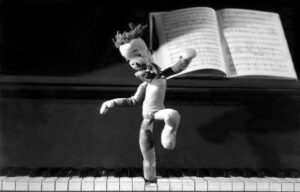
THE CHRISTMAS DREAM
Castle Films, 1949
The idea that toys can come to life and be unhappy when children don’t play with them was not invented for the famed Disney “Toy Story” movies. It’s been a theme in Christmas films for decades.
This is the Castle Films edition of “Vánocní sen,” a 1946 Czechoslovakian film by brothers Borivoj and Karel Zeman, released theatrically in the US in 1948.
The stop-motion animation of the puppets by the Zeman brothers is quite remarkable and is blended very well with the live action little girl who, alas, is unidentified.
The original version of this charming Christmas film was the first to win the Best Animated Short award at the very first Cannes Film Festival in 1946. (1949 Kodak film stock, variable area sound track.)



MERRY CHRISTMAS
(Ambassador Films Inc., c. 1948)
The famed Vienna Choir Boys sing Christmas songs while they decorate the Hapsburg Empire’s Palais Augarten, which became their new home following WWII.
Playing the part of their house mother and also singing with them is Austrian Operatic Soprano Hilde Konetzni (1905-1980, see photo above).
Playing the part of the priest is rector Josef Schnitt (1885-1955) who figures very prominently in the history of the choir. Schnitt was the last imperial chaplain of the Hapsburg Empire. When the Empire fell after WWI the new government was not interested in supporting the choir. Schnitt used his own money to reorganize the choir and then arranged for its first public concert in 1924 which was a notable success. Under Schnitt’s supervision, the Vienna Boys Choir went on to the world wide fame that continues into the twenty first century, supported by private schooling and an active choral training program.
The Christmas songs in this film are of German and Austrian origin and most are unknown to people in the United States. All of the songs are sung in German and some are sung with an Austrian dialect. Translations of the songs will be provided in the printed program at your screening. (1951 Kodak film stock, density sound track.)


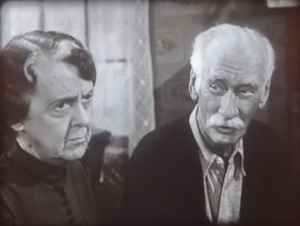
THE GUIDING STAR
CBS Television Network, December 10, 1949.
Non-theatrical distribution, Family Films c. 1950
Uncle Henry is always meddling in other people’s lives by quietly doing good deeds, and he really confuses his family when he brings home a young woman with a baby on Christmas Eve. But Uncle Henry knows far more about this woman and her baby than he’s telling anyone.
This episode of “The Silver Theatre” television anthology series (1949-1950) stars Clem Bevens (1880-1963) as Uncle Henry, and Clara Blandick (1876-1962) (best known as Auntie Em in the “Wizard of Oz”) as Mrs. Jackson. This episode was nominated for an Emmy in 1950 as “best film made for and viewed on television.”
Set in 1906, this neglected gem about bitterness, redemption and the joy of spreading love glows with the true meaning of Christmas.
We will see the 1950 Family Films release of this program. The commercial breaks were removed for this release. (1951 Kodak film stock, density sound track.)



ARMY-NAVY SCREEN MAGAZINE #41
Released to military theaters in November, 1944. “A pictorial report from all fronts for the armed forces only, produced by Army Information Branch, Army Pictorial Service, Air Forces, Navy Department, in cooperation with all united nations.
Shown only to members of the armed forces, this film opens with a brief newsreel showing some American fliers whom the Russians had liberated from a Nazi POW camp in Romania. There is some very historic footage here, including excerpts from the welcome home address given by the commanding officers when the former POWs arrived in Italy.
The rest of the film presents “an Army-Navy Screen Magazine Special: Christmas 1944.” Featured is Leopold Stokowski who addresses the military audience through the camera lens and then conducts the Westminster College Choir (from Princeton, New Jersey) in some Christmas Carols, inviting us to sing along with them to the words on the bottom of the screen.
Then “Stokie” introduces “my good friend, Miss Marian Anderson,” the legendary American contralto, who also speaks to us through the camera lens before singing Schubert’s “Ave Maria.” (Photo above is a frame from the film showing Marian Anderson and Leopold Stokowski.) The film ends with Stokie inviting us to sing along to more carols.
“The Army-Navy Screen Magazine” was a bi-weekly series produced from June of 1943 until early 1946 by the Army Signal Corps under the supervision of Frank Capra. It was said to have reached over 4 million military men and women every week. (Composite print on 1944 and 1947 Kodak film stocks, variable area sound track)
NOTE: some incidental nudity is seen briefly in the early part of the film when the liberated Americans are shown from behind as they walk into the showers. As this was a military film and never shown in civilian theaters nudity was not prohibited.
Silver Showcase is proud to have provided footage from this very rare print to be used in the recent documentary “Once in a Hundred Years-the Life and Legacy of Marian Anderson,” (2019) which aired on PBS.
